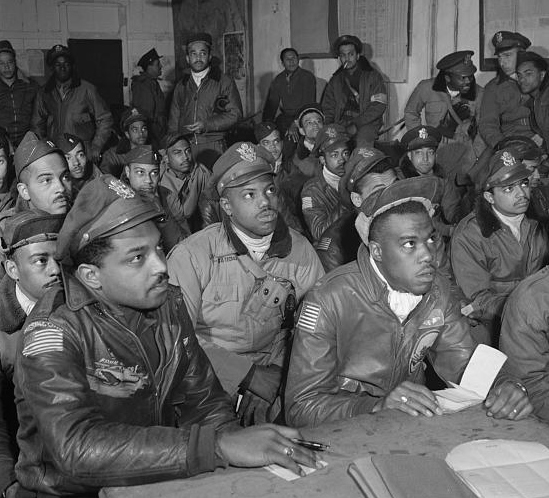
Tuskegee airmen in briefing, Ramitelli, Italy, March 1945. Source: 332nd Group Fighter Pilots and U.S. Library of Congress (public domain).
“The magic of technology is that it allows us to fold space and time to bring people together with places, experiences, artifacts, and each other in ways that before were impossible.” – Malika Saada Saar, Google’s Senior Counsel on Civil and Human Rights.
In celebration of February’s Black History Month and in preparation for the Centennial Anniversary of the U.S. National Park Service occurring on Aug. 25, America’s Secretary of the Interior Sally Jewell announced Feb. 11 that the Google Cultural Institute will “make thousands of historically and culturally significant objects in the [NPS] museum collection available online.” Explained Jewell, Google will photograph and then digitally link artwork, historical records, photographs, and other artifacts to Google Maps, using “technologies similar to Google’s Street View” as part of a partnership agreement with the U.S. Department of the Interior.
“This marriage of technology and history means that anyone anywhere can see artifacts and sites that provide a taste of the rich and diverse story of America,” said Jewell. “Our hope is that this partnership will not only illustrate and elevate our nation’s history and culture, but inspire more people to visit the wonderfully diverse places that the National Park Service protects and preserves for current and future generations.”
With more than 450 million objects and 76,000 linear feet of archived records scattered across nearly 400 national park-based museums, the U.S. National Park Service is now operating one of the largest museum systems worldwide, but simply does not have the physical space to display even a fraction of its holdings. So, this partnership is seen by many public historians and open source enthusiasts as a key victory for the arts and humanities.
One of the park-based museums to be made more visible thanks to Google is the Tuskegee Airmen National Historic Site where Jewell made her announcement as part of a special Black History Month event featuring survivors of the famed World War II Army Air Corps squadron. The collections from the Tuskegee Airmen NHS document the heroism in the air and on the ground of more than 1,000 African-American aviators and 10,000 military and civilian support personnel who defended the nation while raising awareness of the discrimination they faced on the home front.
In addition to bringing more information about the Tuskegee collections to light, said National Park Service Director Jonathan B. Jarvis, website surfers will likely enjoy a special Centennial Virtual Exhibit from the NPS, and “will have the unique opportunity to see rare Native American artifacts, browse inspiring works of art that convey our nation’s history and natural beauty, and virtually walk through the homes of great American thinkers, like Frederick Douglass and Thomas Edison.”
“The magic of technology is that it allows us to fold space and time to bring people together with places, experiences, artifacts, and each other in ways that before were impossible,” said Malika Saada Saar, Google’s Senior Counsel on Civil and Human Rights. “That’s what the Google Cultural Institute does, and we are thrilled to work with the National Park Service to help preserve these beautiful American places, objects, and stories.”

You must be logged in to post a comment.